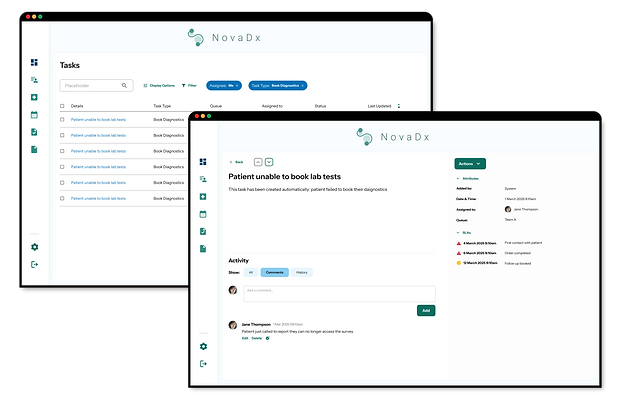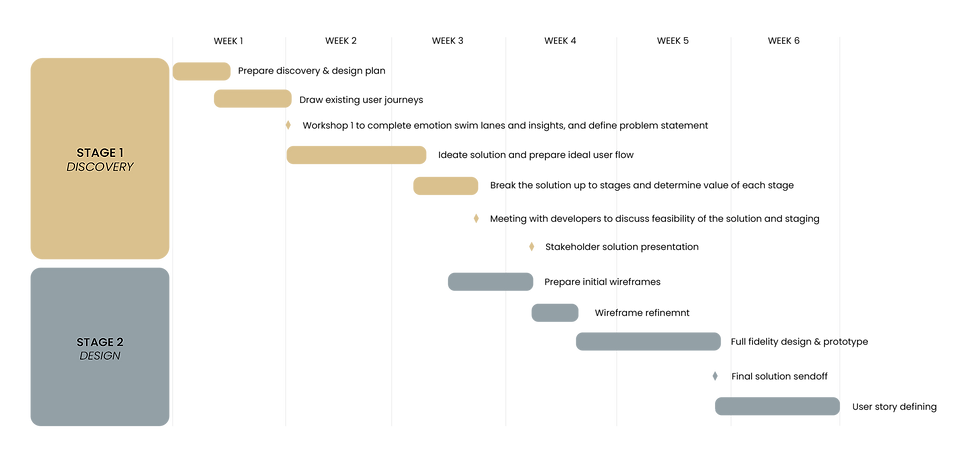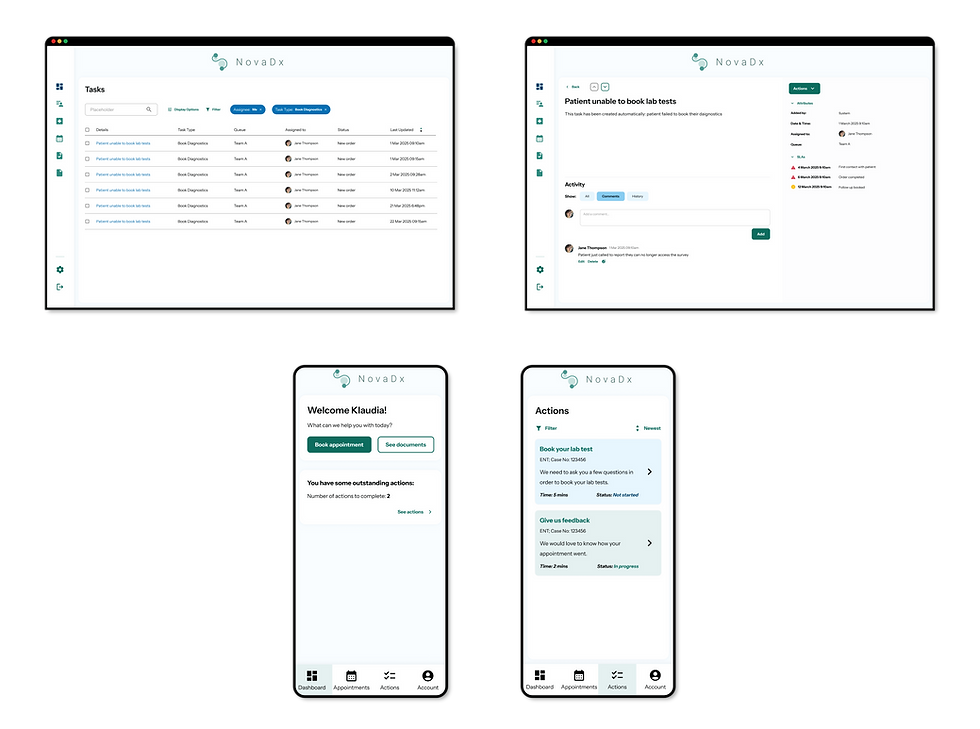Project Type
Service & API Integration into enetrprise B2B / SaaS web application
Methods
UX Workshop (Discovery)
User Journeys
Process Flows
Complexity Quadrants
Stakeholder Collaboration
High-fidelity design
Tools
Figma
Miro
Duration
6 weeks; 4 weeks discovery + 2 weeks design (2025)
Development - in progress

DISCLAIMER: This case study is based on my personal design process and does not disclose any proprietary and confidential company information. All designs and visuals have been modified from the original and do not reflect proprietary company materials.
AT A GLANCE
Role
Sole Product Designer, leading all UX aspects from research to design and stakeholder alignment.
Key Contributions
-
Conducted user workshops
-
Defined user journeys and pain points
-
Designed a phased solution
-
Facilitated cross-functional communication.
Impact
-
50% reduction in patient contact centre interactions for lab test ordering
-
Approximately 200-300 minutes of contact centre agent time saved per 100 lab tests
-
Increased admin user satisfaction
-
Successful and smooth developer rollout of the new feature
-
Minimal to no development rework required
PROJECT OVERVIEW
Background
The organization has been utilizing a diagnostic service as an unintegrated solution for over a year. Over time, this has introduced complexities, leading to additional steps to support its use. Integration of the service became increasingly challenging as these steps became embedded in user workflows. A previous initiative to integrate the service faced feasibility challenges, and concerns were raised about its overall impact. In order to address these challenges, the decision was made to incorporate the feature as an entire new feature with a full UX process for an end-user solution.
Role
As the sole Product Designer in the company, I have taken on leadership of the project. I championed the proposal of approaching this integration as a brand-new feature and the use of the full UX process. I have planned the research and design phases to make sure all aspects of the integration and the process are covered. I coordinated workshops with users to make sure their needs are met, and facilitated stakeholder communication to ensure seamless alignment throughout. I have also worked closely with the Product Owner and developers to ensure understanding and smooth transition of designs to user stories.
Objectives
-
Gain a thorough understanding of the end-to-end user journey for all roles involved in the diagnostic process.
-
Identify and analyze pain points and inefficiencies within the current workflow.
-
Design and present a streamlined solution, encompassing a revised process flow and optimized user journey.
-
Propose a practical and phased implementation plan to deliver incremental value.
-
Ensure alignment and buy-in from all teams and stakeholders regarding the proposed solution and implementation roadmap.

DISCOVERY

Discovery workshops
The biggest challenge of this project was unwrapping the multitude of manual operations and customer support processes involved in ordering diagnostics. In order to fully understand the problem and offer a solution that ensures a smooth diagnostics ordering process while improving efficiency, we had to learn exactly what goes into ordering the tests from all relevant departments. We conducted a total of four workshops with team members from customer support and operations to gain a comprehensive understanding of the full journey.
User journeys
User journeys are a valuable method for UX discovery because they visually map out every step a user takes, along with their emotions, pain points, and interactions. This helps us understand the user’s experience in detail, from both manual and automated processes. By visualizing the journey in one place, we can identify friction points, areas for improvement, and opportunities to enhance the user experience, ensuring a smoother and more intuitive design.

Pain points
Thanks to the above work we were able to identify multiple pain points for both the users, but also for the business. In order to properly evaluate the solution those problems were divided to major, medium and minor based on their affect on the users and the business.
DESIGN
Solution ideation
Building on known pain points, the existing journey, and key objectives, we mapped out an ideal user journey and process flow before crafting mockups for the new solution. Given the complexity of the process, we structured the work into three phases—each delivering meaningful value to both the business and users while steadily progressing toward the full solution.
PHASE 1
This initial phase was shorter than usual due to a later start in the discovery process. The focus was on enabling automatic result uploads to the system, addressing two key pain points and streamlining data processing.
PHASE 2
In this phase, we worked on integrating the order API and designing a user interface for administrators to efficiently manage diagnostic requests. This stage was planned to deliver the highest operational value, improving workflows for administrative teams.
PHASE 3
The final phase centered on integrating the booking API and developing a patient-facing interface. This phase brought all three stages together, enhancing the overall system while improving the experience for patients.

DELIVERY
Alignment
Post-ideation, we conducted a series of sessions to ensure the proposed solution was both aligned with business needs and technically feasible. This included two stakeholder sessions to present and finalize the approach, three sessions with developers—first to introduce the solution and then to review user stories for clarity and feasibility—and a dedicated session with the MI team to ensure they fully understood the implementation and its impact on their workflows. These steps ensured cross-team alignment and a smooth transition from concept to execution.
Addressing Stakeholder Concerns
Following our stakeholder sessions, one stakeholder remained unconvinced about the value of the proposed solution. To ensure alignment and clarity, I scheduled a dedicated meeting with them. With support from the operations team, we prepared a side-by-side comparison of the current and new processes, clearly highlighting key improvements. Additionally, I developed a comprehensive document outlining how the updated process would enhance efficiency, improve SLAs, and positively impact user satisfaction. This structured approach helped bridge any gaps in understanding and reinforced the value of the solution.
OUTCOME
Lessons learned
Through this project, we gained valuable insights into our UX process, particularly in stakeholder collaboration, revision cycles, and process efficiency.
01 STAKEHOLDER INVOLVEMENT
What?
How?
Stakeholders did not have enough exposure to the solution to fully understand its value.
Two presentations after discovery were not enough for a project of this scale. In future projects, we will engage stakeholders earlier and hold more frequent sessions to ensure alignment and prevent late-stage concerns.
02 REVISIONS
What?
How?
The revision phase was too limited to refine the solution effectively.
With only one round of revisions, stakeholders had limited opportunity to fully process the solution and suggest refinements. Next time, we will extend the review period, allowing for more structured feedback sessions and ensuring all concerns are addressed before finalizing the design.
03 PROCESS IMPPROVEMENT
What?
How?
Our process could be improved to better support collaboration and iteration.
The challenges in stakeholder engagement and revision timelines highlighted gaps in our approach. By refining our process to include earlier and more structured feedback loops, we can create a more efficient workflow and deliver stronger business and user outcomes.
Outcome
Despite a few setbacks, the discovery and ideation process was highly successful, as evidenced by strong stakeholder satisfaction with the proposed approach. This also led to enhanced developer engagement, culminating in a seamless and flawless feature development.
